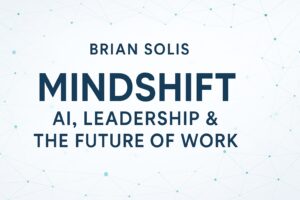
John Pearson over at Pails in Comparison published the first Mindshift review and I just had to share it with you.
To be honest, I was nervous. Like anyone who cares about their work, you wonder how others will experience it.
Let me just share the highlights with you…
I can’t praise this book enough! Why? Before you host your next same-old/same-old strategic planning task force meeting—inspire everyone to read this important book.
Mindshift is next to impossible to review adequately—so I’m just going to bullet-point 20 insights that popped out. (I’ve underlined almost the entire book. Oh, my.) And by the way—the book’s design, graphics, and attention-getting charts are amazing. Mindshift is a joy to read.
1. ALVIN TOFFLER: “The illiterate of the 21st century will not be those who cannot read and write, but those who cannot learn, unlearn, and relearn.”
2. PLEASERS: “Organizational psychologist Taska Eurich has studied self-awareness, and she’s found that there are two types of self-awareness: internal and external.” The 2×2 chart on page 57 is memorable.
• PLEASERS: High External Awareness and Low Internal Awareness
• AWARE: High External Awareness and High Internal Awareness
• SEEKERS: Low External Awareness and Low Internal Awareness
• INTROSPECTORS: Low External Awareness and High Internal Awareness
3. TITANIC! In 1912, Captain Edward John Smith “was captaining a brand new ship with a novel design. But he didn’t bring a new mindset to the mission. He apparently didn’t open his mind to the possibility that this massive ocean liner, the largest built at the time, might not maneuver as readily as he was used to. As the treasure hunter Bock Lovett says in the James Cameron blockbuster film about the sinking, Smith had ’26 years of experience working against him.’”
4. DISCOMFORT. “When we engage in questioning what we’ve learned from our experiences and interrogating our beliefs, we can feel unmoored. Either we can decide to accept that discomfort and sail forward or we can stay tethered to old ways and become obsolete.”
5. BLACKBERRY? “Just think of all the leaders in business that failed to embrace change: Blackberry, Nokia, Blockbuster, Toys R Us, Borders, General Motors…” and more.
6. AQUINAS. “Italian Christian theologian and philosopher St. Thomas Aquinas once warned, ‘Beware of the man with one book.’” (Chapter 4, “The Beginner’s Mind,” is must-read.)
7. MISTAKES. Stanford Prof Carol Dweck contrasts a “Fixed Mindset” with a “Growth Mindset” and includes these values for a growth mindset:
• “Mistakes help me learn.
• Is this my best work?
• Feedback is valuable.
• I improve with practice.
• I won’t give up.”
She adds, “Why waste time proving over and over how great you are, when you could be getting better?”
8. FAILURE. “Legendary basketball coach John Wooden once said that no one is a failure until they start blaming others.”
9. BE CURIOUS! View the eighth episode of the first season of Ted Lasso to learn “What Ted Lasso Can Teach Us About Curiosity.” Ted Lasso quotes Walt Whitman, “Be curious, not judgmental.” View the three-minute clip here. (Hilarious!)
10. HOLY CURIOSITY. “Einstein believed curiosity is one of humanity’s best traits.” He added, “Never lose a holy curiosity.” (There’s that “curiosity” theme again that keeps popping up in my recent book reviews.)
11. MID-POINT SUMMARY. Brilliant! Halfway through the book, Brian Solis summarizes on one page, in BIG print: “What a journey we’ve been on. Just look at how far we’ve come.” On page 121, he reminds us of 10 themes he’s covered, including:
• “Together…we’ve learned that the door is opening to a novel economy, and it’s an era that needs new leadership.”
• Together we’ve… “learned that even though executives might think they do, they don’t always have all the answers.”
12. SIX STAGES OF MINDSET SHIFTING. Now the fun begins in Chapters 7 to 12: “Receive, Perceive, Weave, Conceive, Believe, and Achieve.” Must-read!
13. MINDSET LEXICON. Five words: “Trendsight, Trendsighting, Trendscape Canvas, Trendfluence, and Trendspark.” (I mean…how can you not read this book with your team?)
14. SLOW DOWN! Oh, my. How do we address those looming trends? How do we sleep at night? Brian Solis has two words for us: “Slow down.” (Now he’s meddling! But it prompted me to play this song at the beginning of a meeting I facilitated last week. You guessed it: “Slow Down,” sung by Chuck Girard.)
15. NO BURDEN. “Early on, as we’re learning not just how to track trends but also how to identify them, letting go of the burden of trying to predict the future. That’s not what we’re trying to do here. We are exploring the trends that might impact our ecosystem. It’s a process of getting smart about the promise or potential of emerging trends. It’s also spending time thinking about how those trends could unfold and what those changes might look like.”
16. WONDER WALL! Let’s do this! The “Wonder Wall” exercise on page 129 is worth the price of the book! Solis writes, “Creating a wonder wall activates your powers of curiosity. It helps you connect the dots between the future you envision and where you are today. The process ignites your childlike sense of wonder and helps you consider the questions with a beginner’s mind and a positive sense of possibilities.” He includes 20 questions he’s found helpful. (Guarantee: You will do a “Wonder Wall” at your next strategic planning retreat.)
Here are two questions (“Wondering Samples”) that popped off the page for me:
• “What WSJ or NYT headline would describe our ideal future state?”
• “If we don’t transform now, what will our tombstone read and when?”
There are 18 more “sample” questions—examples of questions your team might write on post-it notes and then post on your Wonder Wall—“the visual reflection of the things that stoke your curiosity and the things that you can’t stop thinking about, that are burning inside of you.”
17. NARRATIVE VS. NUMBERS. The author writes that the three stages of “weave, conceive, and believe” will help to “develop a story for change that sparks curiosity, conversation, and collaboration, ultimately leading to action.” The power of story is explored—very creatively in these chapters (think Pixar’s storytelling approach)—yet with this warning:
Solis mentions Professor Scott Galloway’s research, “Data may be more truthful, but in the battle between narrative and numbers, most of the time humanity picks narrative.” (However, for a slightly contrarian, but very helpful complementary view, read my review of Making Numbers Count, by Chip Heath and Karla Starr.)
18. WIM (What It Means) EXERCISE. I know you will immediately use this planning tool also. “Think of the WIM exercise as a way of getting to:
• …the what,
• so what,
• and now what…
of every trend.”
19. SCENARIO PLANNING. Don’t skip the section on “a common misconception about the nature of scenario planning.” (Learn about IBM’s 1981 estimate that sales of personal computers would peak at 200,000. “Unfortunately, they were a little wrong.” The number was 25 million!)
20. MAKE YOUR STORY PERSONAL. In Chapter 10, you’ll read about “Connecting Trends to the Human Condition by Making Your Story Personal” and stories that appeal to our deepest emotions: anger, disgust, fear, happiness, sadness, and surprise. You’ll learn from “the world’s best-known and most respected screenwriting lecturer” as referenced in HBR’s article, “Storytelling That Moves People.” (And you’ll want to get the popcorn and enjoy the classic movie, Monsters, Inc.)
The author notes that “the best stories are about the human condition we all share”—and page 195 includes a graphic with 18 themes you can leverage. The assignment: “Consider how you might tell a story about a trend in a way that shows how that trend can help your audience with these universal aspects of life.”
Reminder: I told you this book is next to impossible to adequately review. I still haven’t done it, so please read this book yourself. (I might write a second review of this book down the road—it’s that good and it’s that important.)
Order Mindshift on Amazon and learn more about the book here.





Leave a Reply